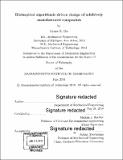Bioinspired algorithmic-driven design of additively manufactured composites
Author(s)
Gu, Grace Xiang
DownloadFull printable version (24.81Mb)
Other Contributors
Massachusetts Institute of Technology. Department of Mechanical Engineering.
Advisor
Markus J. Buehler.
Terms of use
Metadata
Show full item recordAbstract
After billions of years of evolution, it comes as no surprise that biological materials are identified as invaluable sources of inspiration in the search for new materials. Bone, teeth, and spider silk, to name a few, are high-performing biological composites that possess impressive mechanical properties unmatched by their engineering counterparts. Many required mechanical properties in engineering practice are inherently conflicting. In contrast, natural materials can often avoid these fundamental compromises through sophisticated hierarchical structures. Additive manufacturing, with its layer-by-layer fabrication capabilities, facilitates leveraging natural material design to create complex bioinspired architectures. Expanding the design space, however, is indiscriminate in terms of specific material property optimization. In order to best use the templates derived from nature, there needs to be a process to match form to function. This thesis provides a framework that focuses on emulating the simple, yet elusive, design paradigms of nature - simple in their constituent building blocks and elusive in their underlying complexity. At the same time, using simulation and experiments we elucidate the mechanisms that generate their superior properties. A main undertaking of this thesis is to further improve and adapt biological designs for engineering requirements through algorithms and machine learning. Specifically, this thesis takes nacre and conch as model natural materials and deconstructs them in the bioinspired algorithmic-driven design (BADD) framework to build up rationally designed engineering composites. In this work, we show that structural feature placement introduces hierarchy and can amplify mechanical material properties, especially at the interfaces of composites. Heterogeneous material interfaces allow for diffuse load transfer at the interface, leading to a more distributed strain field enhancing overall toughness and strength of composites. Dynamic and static test loading cases, together with simulation provide validation, demonstrating the effects of hierarchy and heterogeneity on composite impact performance. Furthermore, microcracks can be exploited as an impact-enhancing mechanism for hierarchical composites under dynamic loading. Incorporation of machine learning generates new superior designs with a minimal training set and provides orders-of-magnitude faster exploration of design space compared with traditional methods. These concepts lay the foundation for our approach to designing rationally toughened composites to be used in protective gear, energy applications, industrial components, and beyond. The BADD framework can be further used to study other natural or synthetic materials of interest. In the future, this bioinspired machine learning approach will enable materials-by-design of complex architectures to meet demanding engineering challenges.
Description
Thesis: Ph. D., Massachusetts Institute of Technology, Department of Mechanical Engineering, 2018. Cataloged from PDF version of thesis. Includes bibliographical references (pages 189-206).
Date issued
2018Department
Massachusetts Institute of Technology. Department of Mechanical EngineeringPublisher
Massachusetts Institute of Technology
Keywords
Mechanical Engineering.